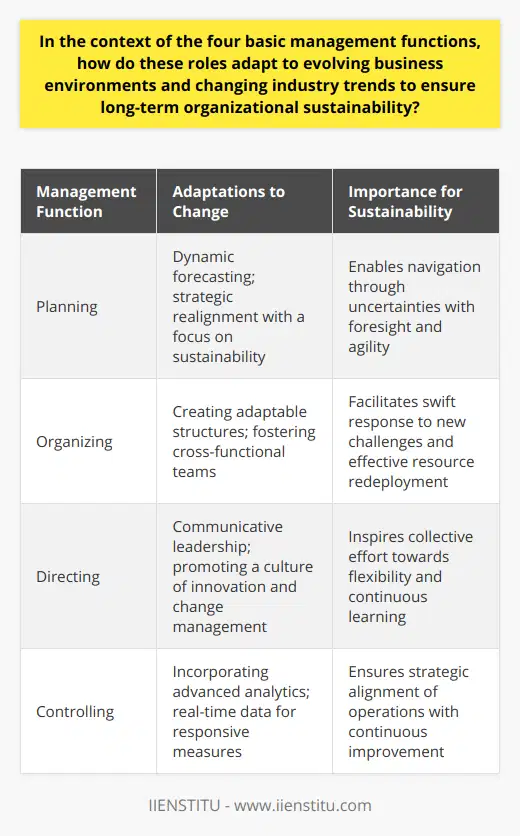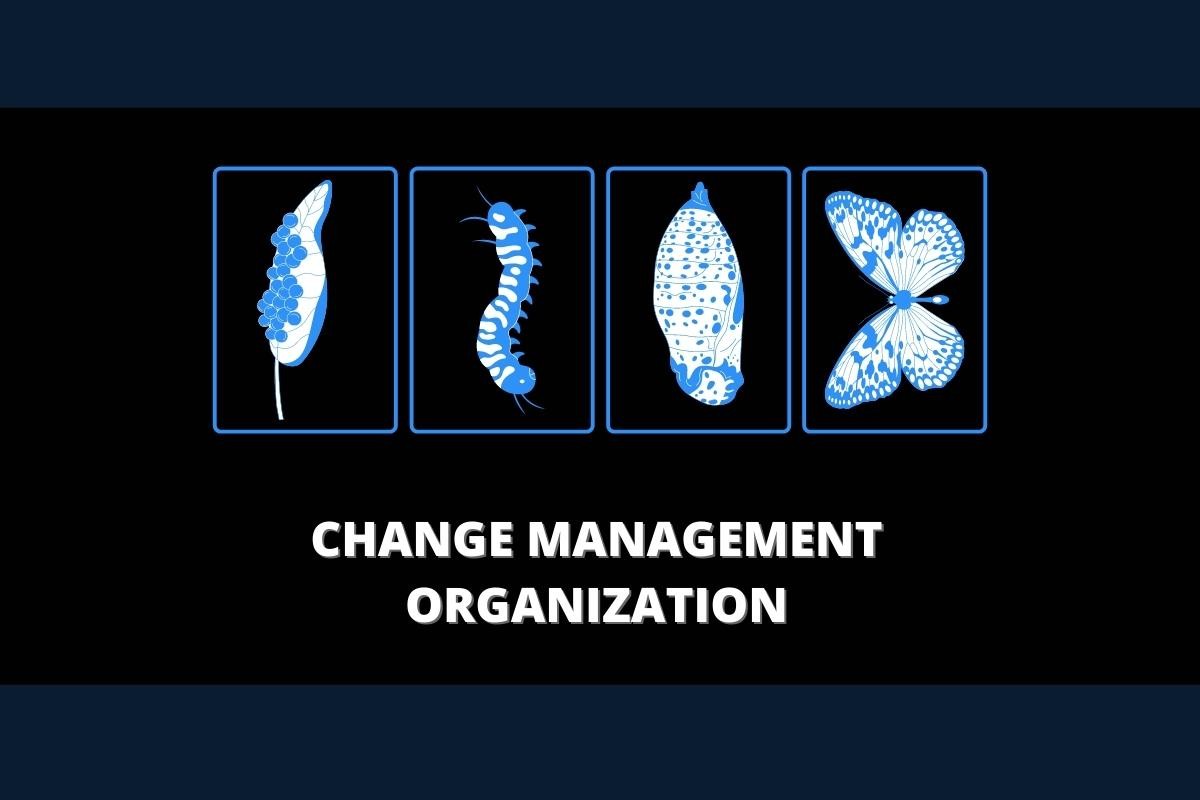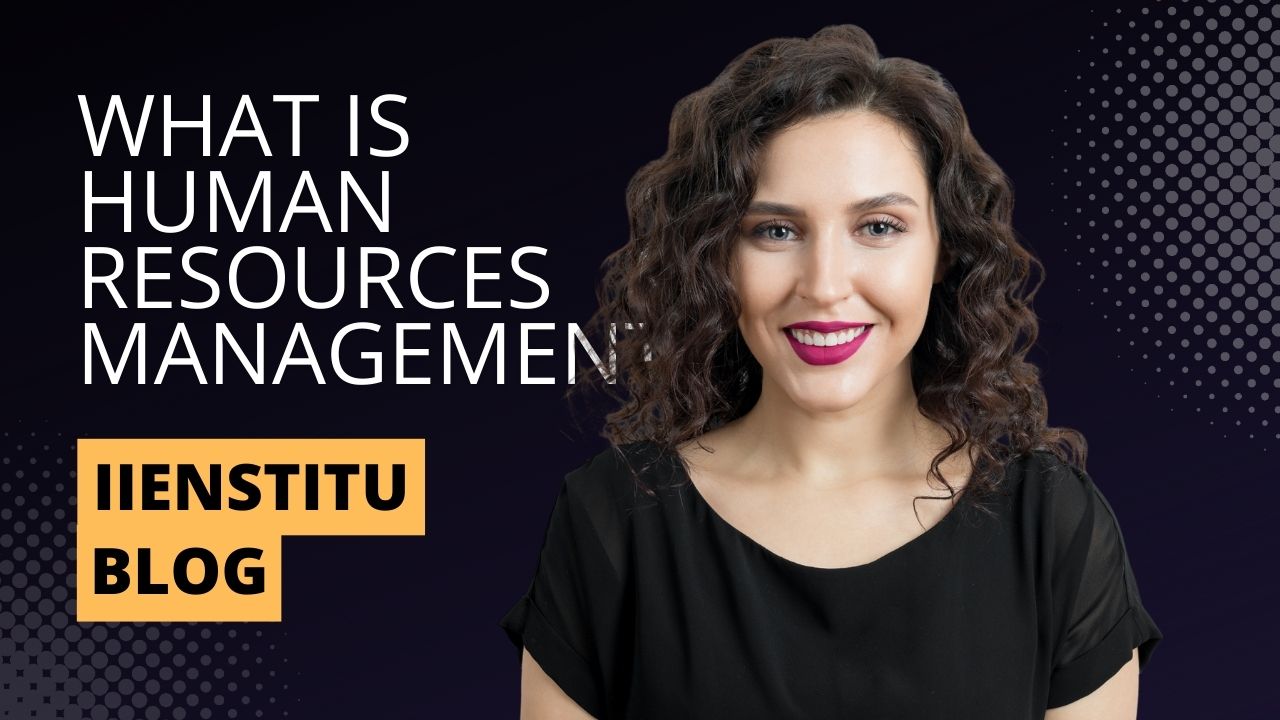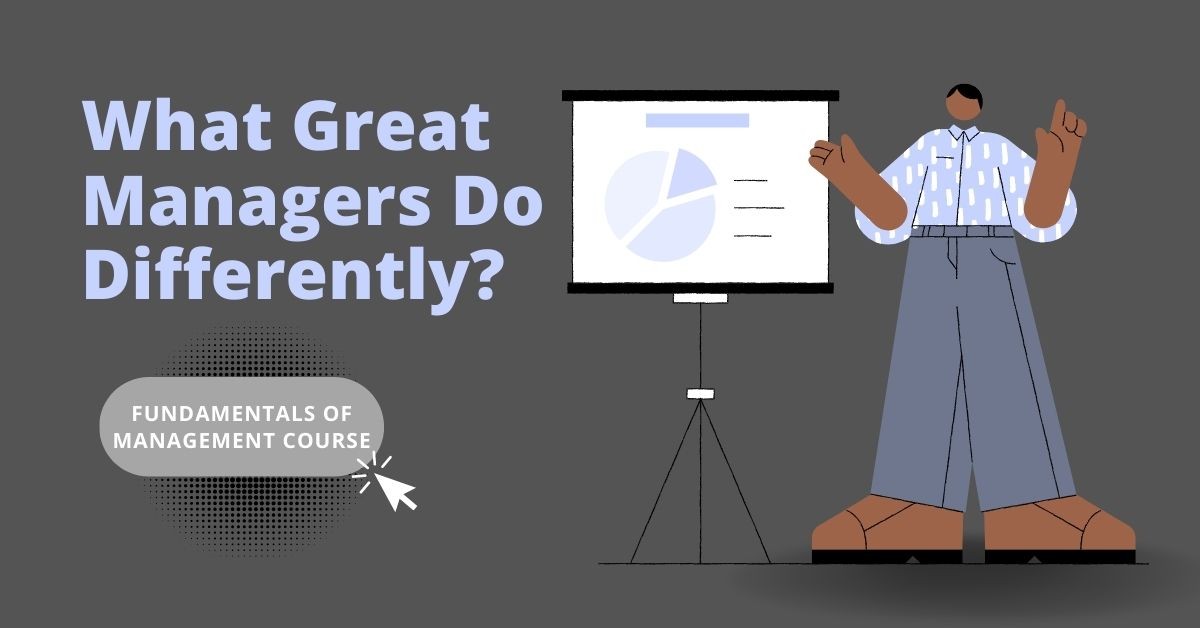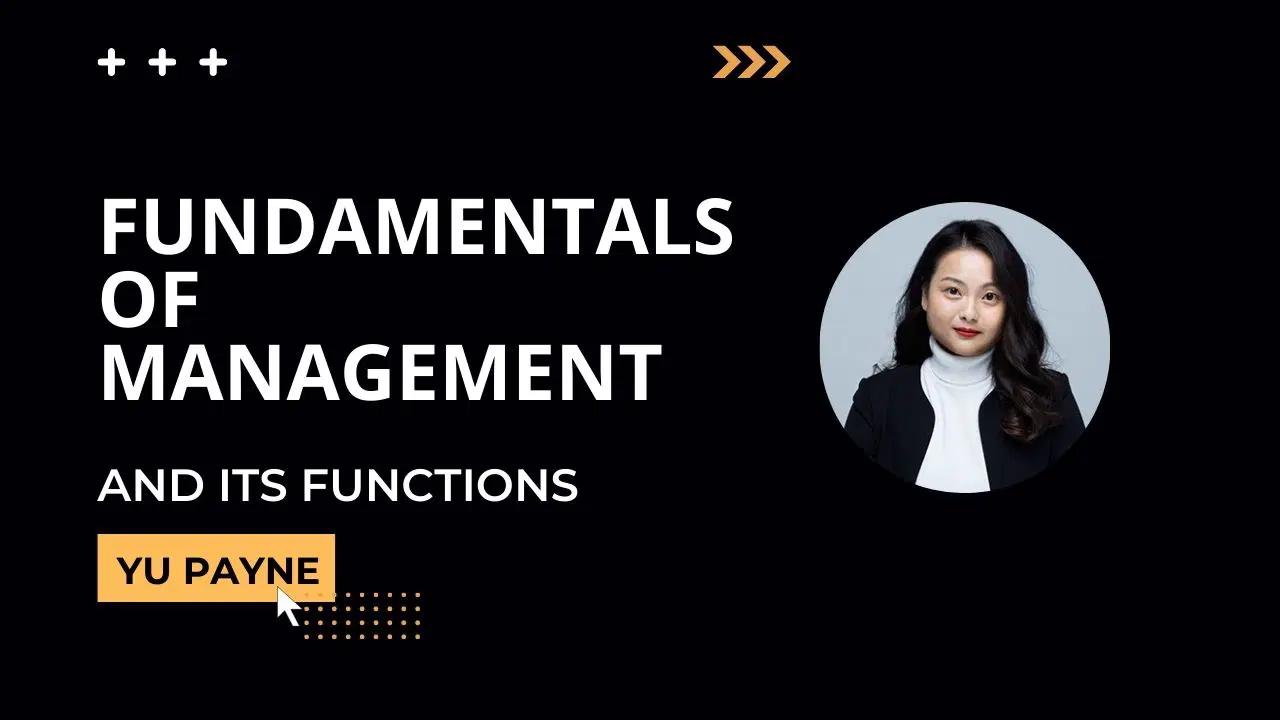
Management analyzes data, organizes it into helpful information for decision-making, and directs people towards achieving goals. There are five primary functions that makeup management:
1- Planning & Directing
The first function of management is planning and directing. Planning occurs when there is a need to determine what must be done to reach an objective. This can be done by formulating a goal and choosing the best course of action.
The following function is directing, which is communicating goals and providing feedback. Communication occurs by setting goals and objectives with employees and ensuring they understand what they need to do.
2- Workplace Environment
The second function of management is creating an environment for employees. This involves providing the proper equipment, safety measures, and supervision. This function also includes workers' compensation for employees injured on the job.
3- Deciding What Resources To Use How They'll be used
The third function is decision-making about what resources to use. Decisions involve choosing employees, machines, or other technology to provide the most efficient way to produce goods or services.
4- Collecting And Analyzing Information Used For Decision Making
The fourth function of management is collecting and analyzing information used for decision-making. This involves researching relevant Statistics about the industry, marketing trends, customer behavior, and other information that will help determine the best way to handle situations.
5- Communicating Results Of Leadership Process
Related Course: Leadership Training Course
The final function of management is communicating the results of leadership. This includes sharing decisions and any relevant information with employees and customers. Employees need to be aware of decisions that will affect their job effectively.
The Importance Of Leadership In Management
Leadership is one of the most important aspects of being a successful manager. Leadership teaches you how and when to show up, what your goals should be for any given team/department to achieve those objectives quickly with minimal conflict from other teams members who may have different priorities or ideas about where things need to go next; it also provides direction on tasks within each unique situation- whether that means taking care business as usual until something changes externally (like an emergency), making significant adjustments based off new information coming through during daily communications or any other given circumstances.
Leadership also teaches you how to be a manager; it tells you what traits successful managers need to have (practical communication skills, managing team members without micromanaging, listening, and understanding what other people are saying and feeling). It provides you with ideas on how you can be a better manager.
Leadership isn't just crucial for managers it's important for everyone- leaders are hard to come by, so it is one of the most sought out positions throughout organizations everywhere. Without leadership, it will be hard to motivate employees to move in the same direction.
As a manager, you must know how to lead your team- you must also set an example for them by following leadership skills yourself. You are not exempt from learning how to be a leader! Your employees are listening and watching what you are doing and taking notes on how you are leading the team. Remember that your employees are always watching and taking everything you do into account- it's essential to lead by example!
If you want to be a great manager, make sure leadership skills are something you prioritize. Leadership isn't just about being respected. It's about doing what is best for the company as a whole. This means leading your team and setting objectives and following those objectives, or putting yourself in another position within the company if you cannot complete a goal (like a promotion). It's about understanding that all things may not go as planned and finding solutions. It's also about having high morale and vision for everyone working at the company.
Now that you have learned about the importance of leadership in management consider what personal leadership skills you have- are there any traits people admire about you? Do you have any leadership skills that you would like to find within yourself (like patience, the ability to see multiple points of view)? Remember that everyone has different leadership styles- make sure yours works well with your team and company!
How To Managing Motivate Employees With Rewards And Incentives
The best way to motivate employees is with rewards and incentives. Whether it be an awards ceremony, Certificates, or cash, the right motivation can significantly impact their performance!
Employees are motivated by different things. Some are motivated by praise. Some prefer tangible rewards like trophies or even cash. Effective managers know what motivates their employees and how they can be best motivated.
Surprising incentives are often very effective. One of the most powerful ways to motivate employees is to reward them for something they didn't expect or didn't even know they were working towards. Alternatively, it can be a good idea to offer an enticing incentive that you know will work well with your company culture. For example, an awards ceremony or office lunch is a great way to motivate employees who enjoy public recognition. Or you could offer bonuses for advancing your company's goals, such as hitting revenue targets.
However, it is essential not to underestimate the impact of small incentives and rewards. Little things like giving praise and showing appreciation can go a long way towards motivating employees. It's also important to appreciate an employee's hard work and show them that you notice it. Rewarding employees for their achievements will also encourage others, as they want to live up to those standards.
If you don't want to offer a tangible incentive, then another great idea is to reward employees by giving them opportunities within the company. For example, an employee struggling at their job could be rewarded with a promotion or a chance to attend a training course.
In conclusion, the best way to motivate employees with rewards and incentives is by matching their needs. Whether an employee enjoys public recognition with a lunch or awards ceremony, or you want to offer bonuses for advancing your company's goals - the right incentive can make a massive impact on employee performance! Learning the fundamentals of management is important for work life. If you want to work on a leader and manager positions, begin learning with this course. You can join IIENSTITU’s fundamentals of management course and get the certification. Good luck!
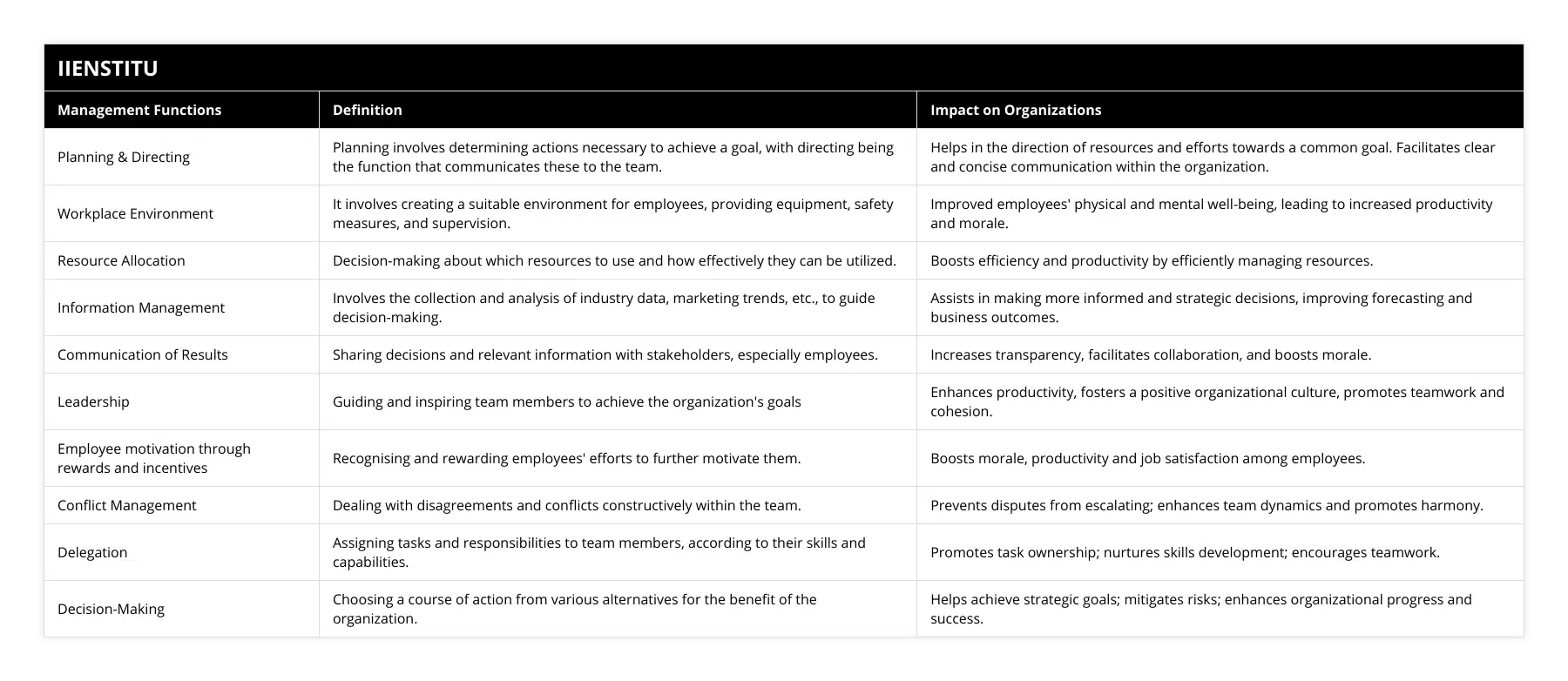
Frequently Asked Questions
What are the four basic functions of management and their significance in organizational success?
Functions of Management
Organizational success is anchored on effective management, which hinges upon the execution of four basic functions: planning, organizing, leading, and controlling. Each function plays a crucial role in ensuring the smooth operation of an organization and the achievement of set goals.
Strategic Planning
Planning entails defining strategic objectives and establishing a roadmap for attaining them. This process requires managers to analyze internal and external environments, foresee potential challenges, and develop contingency plans. By effectively planning, organizations establish a framework to measure progress and identify deviations from established objectives, allowing them to adapt to dynamic market conditions.
Effective Organizing
Organizing involves the allocation of resources and the establishment of organizational structures that ensure efficient utilization of these resources. Managers must assign roles and responsibilities, create chains of command, and determine proper communication channels. Organizing allows an organization's members to work harmoniously with a clear understanding of their roles, ultimately promoting operational efficiency.
Inspirational Leadership
Leadership encompasses the ability of managers to influence, motivate, and inspire team members to achieve organizational goals. This function involves setting clear expectations, providing guidance, fostering a healthy work environment, and nurturing individual talents. Effective leadership is vital in empowering employees, driving innovation, and facilitating the adaptation of organizations to evolving market dynamics.
Performance Control
Lastly, controlling entails monitoring organizational processes and evaluating employee performance based on predetermined standards. Managers use various control mechanisms, such as performance appraisals and financial audits, to identify areas that require improvement and devise corrective measures. Adequate control mechanisms ensure that an organization maintains high productivity, financial stability, and ethical standards.
In conclusion, the four basic functions of management - planning, organizing, leading, and controlling - are of paramount importance for organizational success. Proper execution of these functions fosters efficiency, innovation, and adaptability, all of which are indispensable in today's constantly evolving business landscape.

How do management fundamentals contribute to effective leadership and decision-making within a business setting?
Management Fundamentals in Effective Leadership
Effective leadership and decision-making within a business setting are essential for achieving organizational goals and maintaining a high level of employee engagement. Management fundamentals, which include planning, organizing, directing, and controlling, contribute significantly to these outcomes by providing a structured framework for leaders to operate within.
Planning for Success
One of the core management fundamentals is planning, which involves setting objectives, defining the means to achieve them, and creating a schedule of activities. A leader who understands and effectively utilizes planning can make informed decisions, anticipate challenges, and allocate resources according to the priorities of the business.
Organizing Resources
Another key managerial function is organizing, which entails arranging and coordinating resources to ensure that work processes run efficiently. Effective leaders recognize the importance of organizing and allocate human, financial, and technological resources to maximize productivity, thereby promoting sound decision-making practices within the organization.
Directing Employees
In addition to planning and organizing, directing is also a crucial management function. This involves providing guidance, motivation, and supervision to employees to ensure that they perform their tasks effectively. A leader who excels in directing is able to communicate expectations clearly, foster a positive work environment, and inspire employees to achieve their potential, all of which contribute to better decision-making within the organization.
Controlling and Monitoring Performance
Lastly, controlling is a management function focused on monitoring performance and ensuring that objectives are met. Effective leaders use various tools, such as performance appraisals, to assess progress and ensure that adjustments are made as needed. By regularly measuring performance, leaders can make informed decisions based on accurate data, which in turn leads to better outcomes for the business.
In conclusion, management fundamentals contribute to effective leadership and decision-making within a business setting by providing a structured and systematic approach to achieving objectives. A leader who demonstrates competence in planning, organizing, directing, and controlling not only fosters a productive work environment but also drives their organization toward success.
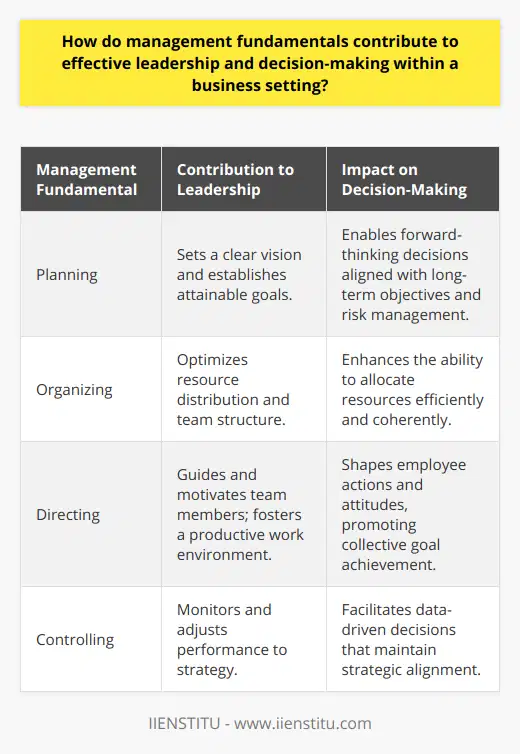
In the context of the seven main functions of management, how do these roles interact and support one another in achieving organizational goals?
Interdependence of Management Functions
Within an organization, the seven main functions of management – planning, organizing, staffing, directing, coordinating, reporting, and budgeting – interact closely and are mutually supportive, ultimately contributing to the achievement of organizational goals.
Foundational Role of Planning
Planning serves as the foundation for other management functions, as it establishes the blueprint for action. By setting clear objectives, defining strategies, and allocating resources, planning facilitates decision-making and enables a smooth transition to other management tasks.
Organizing for Enhanced Structure and Communication
After the planning phase, organizing is critical for establishing a formal structure of tasks, responsibilities, and authority within the organization. This division of labor allows managers to effectively allocate resources and clarifies communication channels between team members, reinforcing the interconnected nature of managerial functions.
Staffing for Optimal Performance
To ensure a competent workforce, staffing focuses on recruitment, selection, placement, and training of employees. A skilled and motivated team is essential for the seamless integration of the broader functions of management, ultimately driving the organization toward its goals.
Directing Through Strong Leadership
The directing function empowers the workforce to carry out the tasks outlined in the planning and organizing stages, by providing leadership, motivation, and guidance. Strong leadership is instrumental in aligning individual objectives with overarching organizational goals, paving the way for a harmonious interplay between management functions.
Coordinating for Greater Efficiency
Coordination unifies the efforts of different departments or individuals, mitigating potential conflicts and allowing managers to monitor progress towards organizational goals. With proper coordination, the other management functions can be executed more efficiently and effectively.
Reporting for Informed Decision Making
The reporting function facilitates informed decision-making through the collection, interpretation, and dissemination of critical information. This feedback loop enables managers to realign strategies, course-correct as necessary, and refine other managerial functions as the organization strives to meet its objectives.
Budgeting for Strategic Resource Allocation
Lastly, budgeting controls the deployment of financial resources, enhances the cost-effectiveness of operations, and gauges the financial performance of the organization. This function ties together the various aspects of management, as it impacts planning, organizing, staffing, directing, and controlling within the organization.
In conclusion, the interdependence of the seven main management functions ensures a systematic and holistic approach to running an organization. This interconnectedness, driven by the alignment of individual and organizational goals, fosters an environment in which the achievement of overall objectives becomes an attainable reality.
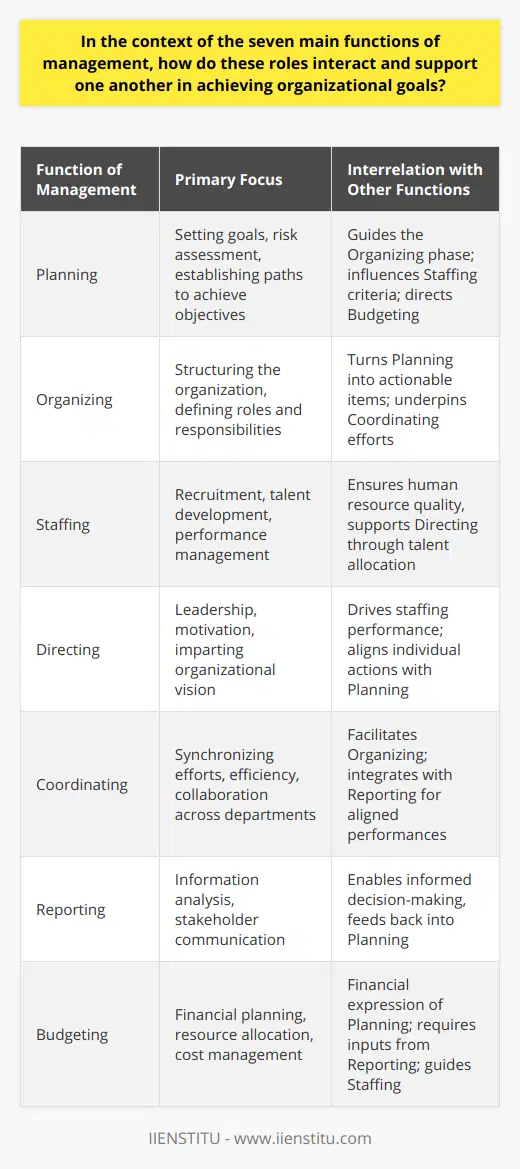
What is the underlying purpose of the four fundamentals of management in guiding an organization towards its objectives?
Fundamental Importance of Management
The underlying purpose of the four fundamentals of management - planning, organizing, leading, and controlling - is to effectively guide an organization towards achieving its objectives. Collectively, these fundamental elements create a robust framework that supports organizational growth and performance.
Planning: Setting Direction
Planning plays a critical role in establishing a clear direction for the organization, enabling a company to establish well-defined goals and devise strategies to attain these objectives. This process assists managers in identifying potential opportunities and threats, while allocating necessary resources to exploit the former and mitigate the latter.
Organizing: Aligning Resources
Organizing entails structuring the organization in a manner that facilitates efficient allocation and utilization of resources. It involves segregating tasks, placing them into departments, and ensuring smooth communication between various units. An organized structure enhances workflow and fosters synergy within the organization, thus contributing significantly to achieving organizational objectives.
Leading: Inspiring Action
Effective leadership entails motivating, directing, and inspiring employees to prioritize organizational objectives and work collectively towards their attainment. Leadership bridges the gap between planning and execution, enabling managers to influence and guide employees towards adopting desired behaviors and attitudes. The leaders' ability to create a positive work environment and foster teamwork significantly impacts the organization's ability to stay on course in pursuit of its goals.
Controlling: Monitoring Progress
Controlling involves monitoring the organization's progress towards achieving its objectives and making the necessary adjustments to ensure success. By establishing performance benchmarks and evaluating actual outcomes, managers identify deviations from the plan and implement corrective measures to realign organizational efforts. Strong control mechanisms facilitate performance improvement, optimize resource utilization, and safeguard desired outcomes.
In conclusion, the four core fundamentals of management work in unison to ensure an organization's guidance towards achieving its objectives. Planning provides a clear direction, organizing structures the system, leading inspires action, and controlling ensures progress monitoring and adjustment. This comprehensive framework underpins successful organizational management and is instrumental in consistently realizing the company's vision and goals.
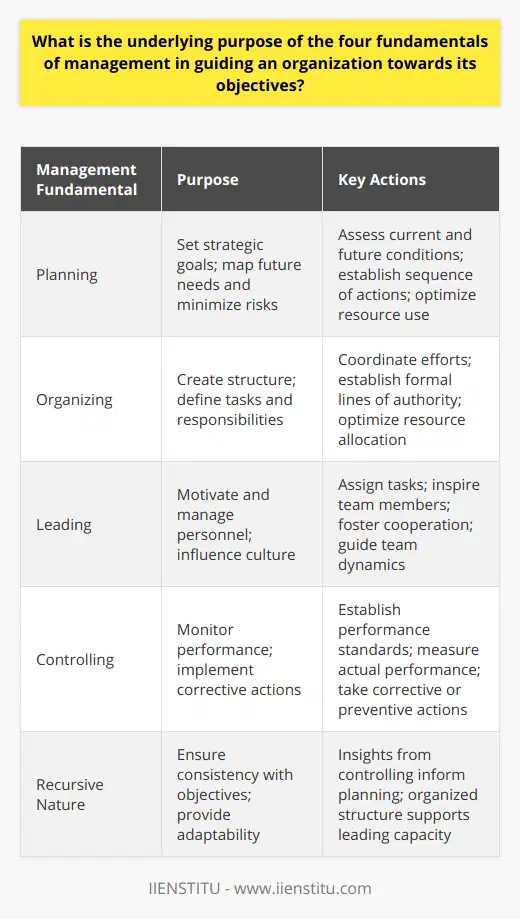
How do the seven management functions facilitate comprehensive and effective administration within an organization?
The Role of Management Functions
The seven management functions play a crucial role in facilitating comprehensive and effective administration within an organization. These functions are planning, organizing, staffing, directing, coordinating, reporting, and budgeting. Each function contributes to the achievement of organizational goals and ensures smooth operations.
Planning for Success
The planning function involves setting objectives and formulating strategies to achieve them. By establishing clear goals and a roadmap to reach them, management can allocate resources efficiently, anticipate challenges, and foresee opportunities. This process allows for a proactive approach to decision-making and ensures the organization is always moving towards its intended targets.
Organizing Resources
Organizing involves the arrangement of resources, including human, financial, and physical assets. By establishing an effective organizational structure and assigning roles and responsibilities, management ensures a clear division of labor and facilitates the optimal use of resources. Consequently, this function helps streamline processes, reduce duplication of efforts, and resolve resource constraints, which enhances efficiency and productivity.
Staffing and Skills Development
The staffing function encompasses the recruitment, selection, and training of competent employees. By ensuring an organization has a skilled workforce with the right mix of expertise, management can capitalize on employees' strengths and achieve optimal results. Additionally, continuous employee development helps organizations adapt to changing business environments, reduces staff turnover, and fosters a culture of continuous improvement.
Directing Towards Goal Achievement
Directing entails guiding and motivating employees to achieve organizational goals. Through effective communication, leadership, and management styles, managers can foster a positive work culture, inspire employees, and address their concerns. In turn, this generates employee satisfaction, loyalty, and commitment, which ultimately enhances productivity and contributes to the achievement of organizational objectives.
Coordinating for Efficiency
Coordination is the synchronization of various tasks and functions across an organization to ensure smooth functioning. By facilitating communication, collaboration, and information sharing among departments, management can avoid bottlenecks, minimize conflicts, and maximize synergies. This function allows for better decision-making and faster execution of tasks, which in turn, improves overall efficiency.
Reporting and Performance Monitoring
The reporting function involves collecting, analyzing, and presenting information about the organization's performance. Regularly assessing performance against established metrics allows management to identify areas of improvement and implement corrective actions. The reporting function also ensures transparency, accountability, and effective performance management, which are essential for achieving organizational goals.
Budgeting for Financial Control
Lastly, budgeting is the process of allocating resources and estimating expenses to achieve financial objectives. Effective budgeting fosters financial control, helps in cost reduction, and supports growth and development. By closely monitoring and managing budgets, organizations can achieve financial stability, minimize risks, and make well-informed decisions.
In conclusion, the seven management functions are essential for facilitating comprehensive and effective administration within an organization. They ensure goal alignment, optimize resource utilization, enhance decision-making, and promote a culture of growth and development. By effectively implementing these functions, organizations can ensure efficient operations, minimize risks, and ultimately achieve their objectives.
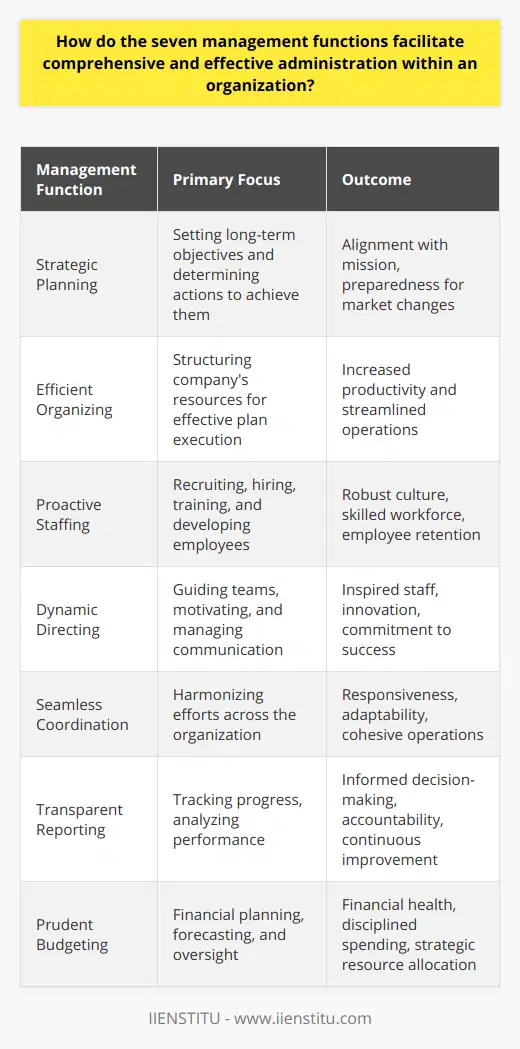
Which of the management functions can be considered as the most crucial in ensuring overall operational efficiency and goal attainment?
Crucial Management Function for Operational Efficiency and Goal Attainment
Role of Planning Function
In ensuring overall operational efficiency and goal attainment, planning stands out as the most crucial management function. This preliminary step not only charts out a clear path for the organization's objectives but also enables resource allocation and sets performance standards while anticipating potential obstacles. By setting SMART (Specific, Measurable, Achievable, Realistic, and Time-bound) goals and expectations, planning facilitates smoother execution of processes and a sense of direction for all team members involved.
Significance of Organizing Function
Organizing, as a management function, establishes an efficient structure by systematically arranging resources in a manner that aligns with the organization's strategic goals. Effective organization streamlines workflows, reduces redundancies, and enhances communication. This ensures that all tasks are executed with maximum proficiency, and the set objectives are achieved without unnecessary setbacks.
Criticality of Leading Function
Leadership plays an essential role in driving operational efficiency and achieving predetermined goals. Effective leadership fosters motivation, collaboration, innovation, and strategic decision-making. By inspiring and guiding team members, leading function ensures that all employees are aware of their roles, responsibilities, and contributions to the organization's success, thereby augmenting overall productivity.
Impact of Controlling Function
Lastly, the controlling function assesses and monitors ongoing operations relative to the set standards and goals. It ensures performance tracking and evaluation with a focus on identifying discrepancies and correcting deviations to adhere to the projected path. This iterative process helps in minimizing errors, mitigating risks, and ensuring consistency, ultimately resulting in improved efficiency and attainment of the organization's objectives.
Conclusion
In conclusion, while each management function contributes significantly to the overall functioning of an organization, planning emerges as the most critical function in ensuring operational efficiency and goal attainment. By setting the foundation for the rest of the functions, planning facilitates a well-structured, organized, and systematic approach to achieving the desired results. Therefore, organizations should prioritize effective planning to enhance their operational performance and reach their objectives.

What are the practical implications of implementing the five basic managerial functions in management for enhancing organizational performance and employee satisfaction?
Practical Implications of Managerial Functions
**Planning for Organizational Success**
Implementing planning as a managerial function enables managers to set achievable goals, allocate resources effectively, and design a comprehensive strategy to drive organizational performance. Regular planning processes support managers in identifying potential challenges and adjusting organizational courses of action accordingly, leading to a more agile and flexible work environment for employees.
**Organizing for Improved Performance**
Organizing is essential for creating a structure that leads to enhanced organizational performance. By clearly defining roles, tasks, and expectations, managers can improve employees' understanding of their responsibilities. This clarity can lead to increased job satisfaction, as employees feel more confident and competent in their work, ultimately contributing to better performance.
**Commanding: Setting the Course**
Commanding involves providing direction and motivation to employees, helping them understand the company's objectives and empowering them to meet those goals. By having strong leadership, managers can foster an environment in which employees feel motivated to perform their best, leading to higher employee satisfaction and improved organizational performance.
**Coordinating for Synergy**
Coordinating ensures that different organizational departments and teams work together effectively. Implementing this managerial function can lead to an increase in collaboration, knowledge sharing, and innovation among employees. As a result, the organization benefits from a workforce that performs more efficiently, while employees experience higher satisfaction from working in a supportive and productive environment.
**Control: Ensuring Accountability and Quality**
The final managerial function, control, focuses on monitoring organizational performance and holding employees accountable for their work. Managers who implement this function effectively can identify potential issues early, make necessary adjustments, and maintain high-quality standards. This level of quality assurance increases employee satisfaction by allowing them to take pride in their work and see the tangible results of their efforts.
In conclusion, implementing the five basic managerial functions in management has several practical implications. These functions contribute to enhanced organizational performance and increased employee satisfaction by fostering a structured, supportive, and empowered work environment. Acknowledging the importance of planning, organizing, commanding, coordinating, and control in management practices can lead to a more successful and satisfied workforce.
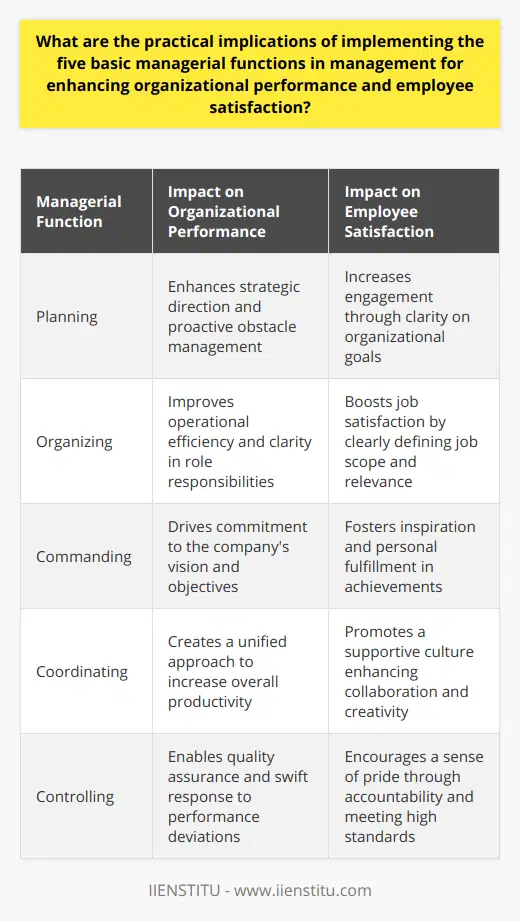
How do the four functions of management align with contemporary leadership theories and approaches in creating a successful organizational culture?
Alignment of Management Functions and Leadership Theories
The four functions of management, namely planning, organizing, leading, and controlling, are essential in shaping and maintaining a successful organizational culture. Contemporary leadership theories and approaches, such as transformational, servant, and situational leadership, provide frameworks that align with these functions to ensure effectiveness, adaptability, and sustainability in today's dynamic business environment.
Planning and Transformational Leadership
The planning function entails setting organizational goals, identifying resources, and developing robust strategic plans. Transformational leadership complements this function by inspiring and motivating team members to embrace and commit to the organization's vision and mission. Transformational leaders foster creativity and innovation and instill a continuous improvement mindset, which is crucial in achieving long-term organizational success.
Organizing and Situational Leadership
Organizing involves assigning responsibilities, allocating resources, and establishing authority structures to ensure effective implementation of strategies. Situational leadership matches well with this function as it emphasizes adapting leadership styles based on individual team members' competence and motivation levels. By tailoring their approach, situational leaders can foster a more efficient task execution, better allocate resources, and improve overall performance.
Leading and Servant Leadership
The leading function focuses on providing direction and support to members while maintaining open lines of communication and promoting teamwork. Servant leadership aligns seamlessly with this function by prioritizing the needs of employees and empowering them to reach their full potential. This leadership approach emphasizes listening, empathy, and stewardship, fostering a high level of trust and commitment, ultimately contributing to a more cohesive and success-driven organizational culture.
Controlling and Remaining Agile
The controlling function involves monitoring progress, evaluating performance, and implementing corrective measures when necessary. Contemporary leadership approaches emphasize the importance of agility, adaptability, and continuous improvement, allowing organizations to quickly respond and adapt to evolving market demands and external pressures. By remaining flexible and maintaining a forward-thinking mindset, leaders can actively align management functions with contemporary leadership approaches to achieve success.
In conclusion, aligning the four functions of management with contemporary leadership theories and approaches plays a crucial role in creating and sustaining a successful organizational culture. The synergistic relationship between management functions and leadership styles fosters adaptability, innovation, and overall success, ensuring that organizations remain competitive and relevant in today's ever-changing global market.
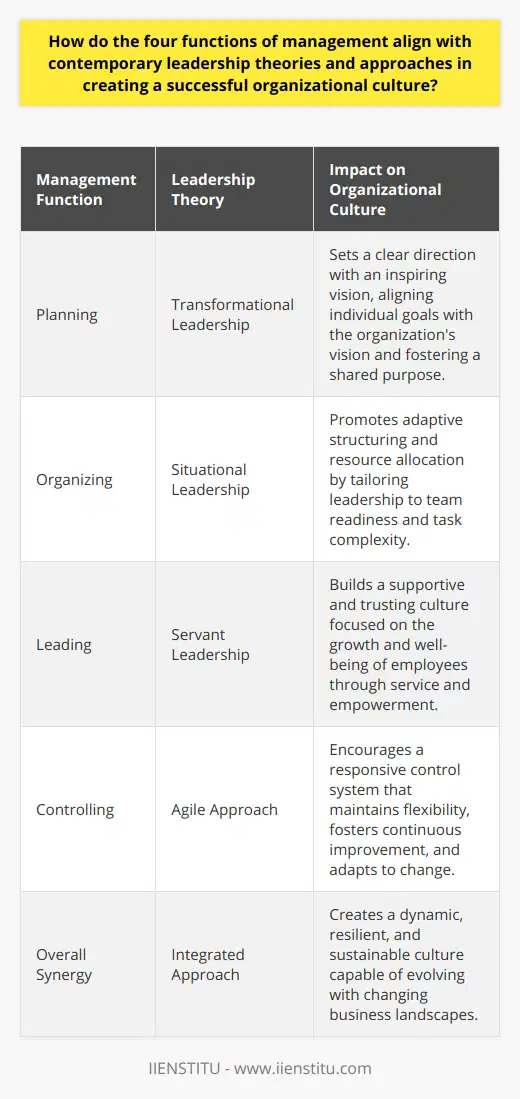
In the context of the seven main functions of management, what strategies can be employed to optimize their effectiveness and ensure seamless integration within an organization's operational framework?
Integrating Management Functions
To optimize the effectiveness and seamless integration of the seven main functions of management within an organization's operational framework, several strategies can be employed. Firstly, it is crucial to establish a structure that aligns with the organization's goals and objectives. This involves creating a well-defined organizational chart which outlines the roles and hierarchical relationships within the company.
Effective Communication
Effective communication is a vital strategy in ensuring seamless integration of management functions. By fostering a culture of openness and transparency, employees can better understand their roles, the expectations of their supervisors, and how their work contributes to the overall success of the organization. Also, adopting digital communication tools like project management software and collaboration platforms can streamline information sharing across various departments.
Teamwork and Collaboration
In addition to enhancing communication channels, promoting a culture of teamwork and collaboration can also help optimize the effectiveness of management functions. Encouraging cross-functional teams and collaboration can lead to better problem-solving, faster decision-making, and increased innovation. Additionally, regularly reviewing and updating processes and workflows to ensure efficiency can help management in planning and organizing tasks successfully.
Managerial Skills Development
Investing in the continuous development of managerial skills within the organization is vital for effective integration of the seven management functions. This can be achieved through regular training programs, workshops, and mentoring sessions. Managers should also engage in self-reflection and learning from both successes and failures, ultimately leading to better decision-making and improved leadership capabilities.
Employee Empowerment
To optimize management effectiveness, it is essential to empower employees within the organization. This can be achieved by offering opportunities for growth and development, as well as granting access to resources and information necessary to succeed in their roles. Empowered employees are more likely to be engaged, motivated, and committed to the organization's goals, which ultimately improves overall productivity and performance.
Monitoring and Evaluating Performance
Lastly, implementing performance monitoring and evaluation techniques is essential for maintaining optimal management effectiveness. Key performance indicators (KPIs) should be established, aligning with the organization's goals and objectives. Regular performance appraisals and feedback loops can help identify areas of improvement and address any issues proactively, resulting in a more efficient and well-integrated management system.
In conclusion, by adopting these strategies, organizations can effectively optimize and seamlessly integrate the seven main functions of management. This will ultimately lead to improved operational efficiency, better decision-making, and increased organizational success.
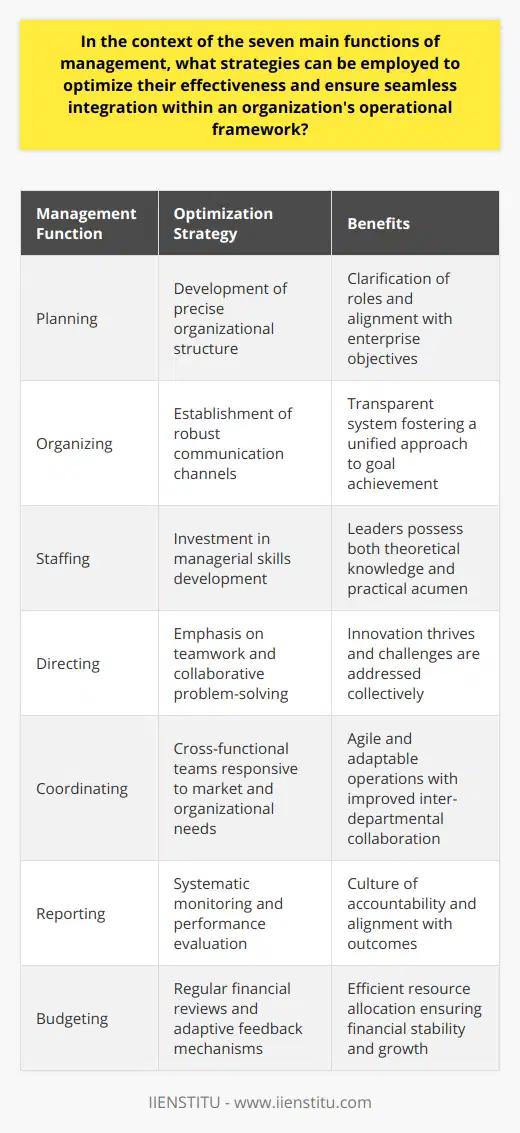
What are the primary distinctions between the four fundamentals of management, and how do they collectively contribute to effective organizational governance?
**Four Fundamentals of Management**
The primary distinctions between the four fundamentals of management - planning, organizing, leading, and controlling - are based on their distinct functions and interconnected relationships in the realm of organizational governance. Each fundamental plays a critical role in achieving a well-rounded and effective management system, focused on meeting organizational goals and maintaining accountability.
**Planning: Setting Objectives and Strategies**
The planning process involves setting strategic, tactical, and operational objectives while outlining the necessary procedures and resources to achieve them. This requires analyzing the organization's environment and evaluating its strengths, weaknesses, opportunities, and threats (SWOT) to establish goals and develop plans accordingly. Planning serves as the first management function, providing direction to the other three core fundamentals and ensuring a coherent approach to organizational governance.
**Organizing: Coordinating Resources and Tasks**
Organizing focuses on coordinating and mobilizing the resources required to execute the plans developed in the prior stage. This includes the allocation of financial, human, and technological resources, as well as establishing suitable organizational structures and communication channels. Proper organizing streamlines workflows, facilitates teamwork, and can enhance organizational efficiency, contributing to the attainment of organizational goals defined during planning.
**Leading: Motivating and Leading People**
The third fundamental, leading, encompasses the actions and behaviors necessary to motivate and influence people to achieve the organization’s objectives. This involves several skills such as communication, motivation, decision-making, and negotiation. Moreover, it requires active monitoring of employee performance and adjustment of management approaches in response to team dynamics. Effective leadership ensures that employees are engaged and committed in working toward shared goals, fostering a productive organizational culture.
**Controlling: Evaluating and Adjusting Performance**
Lastly, controlling entails monitoring the actual performance of an organization against intended objectives and making appropriate adjustments. It is essential to evaluate various performance indicators and identify deviations from the goals set during planning. Controlling allows managers to analyze the outcomes of implemented plans, adjust them when necessary, and learn from the outcomes of the decisions made. This process aids in ensuring the organization maintains accountability and delivers on its commitments.
**Collective Contribution to Organizational Governance**
Having distinct yet interconnected roles, the four fundamentals of management collectively contribute to effective organizational governance by creating a cohesive framework for setting goals, organizing resources, leading people, and monitoring performance. These components work in unison to enhance organizational efficiency, maintain accountability, and ensure the continuous improvement and adaptation of management practices, ultimately bolstering the long-term success of the organization.
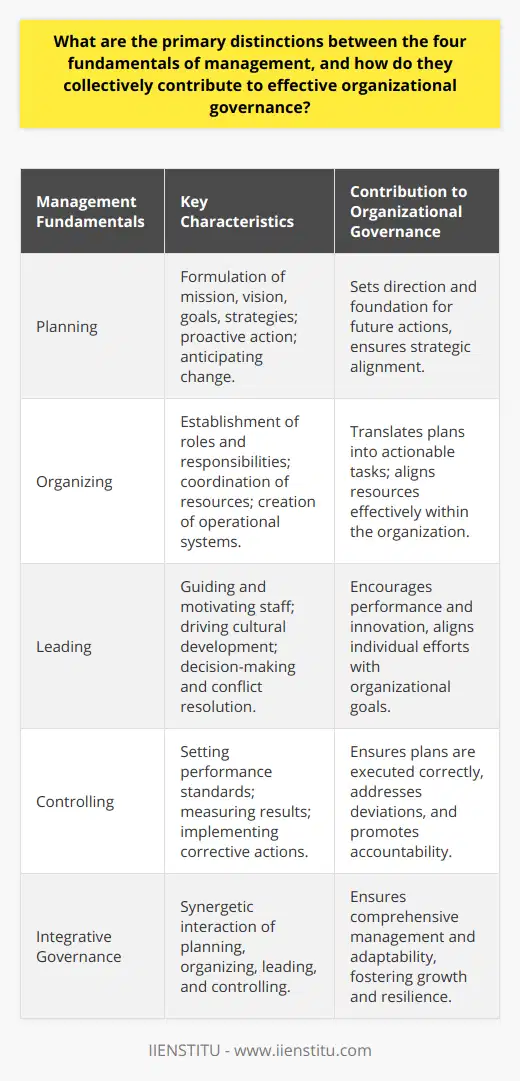
In the context of the five basic managerial functions in management, how do leaders balance and prioritize different aspects of their role to maximize productivity and engagement?
Balancing Managerial Functions
In the context of the five basic managerial functions – planning, organizing, staffing, directing, and controlling – effective leaders balance and prioritize different aspects of their role to maximize productivity and engagement. Successful management of these complex responsibilities demands a holistic approach.
Planning and Setting Goals
The planning stage involves the establishment of realistic objectives that align with the organization's vision. By setting ambitious yet achievable short-term and long-term goals, leaders can inspire employees and boost engagement. Prioritization of tasks and strategic resource allocation is crucial at this stage.
Organizing and Structuring
Effective organizing involves structuring human, physical, and financial resources in a coherent manner. Leaders create a well-defined hierarchy with clear lines of authority and responsibility. By promoting autonomy and flexibility, managers encourage innovation and improved decision-making.
Staffing and Talent Development
Proactive approaches to staffing involve not only hiring skilled employees but also investing in talent development to ensure continuous growth. Engaged employees feel valued, leading to increased efficiency and satisfaction. Leaders prioritize training programs and skill-building opportunities to foster a high-performing workforce.
Directing and Effective Communication
In the directing function, skilled leaders combine motivation, communication, and delegation to guide employees towards the accomplishment of goals. By prioritizing transparent communication channels and fostering a supportive work environment, managers empower workers and facilitate teamwork.
Controlling and Monitoring Progress
Lastly, the controlling function focuses on monitoring progress and implementing corrective measures. Effective leaders establish Key Performance Indicators (KPIs) to evaluate performance and adjust plans accordingly. They prioritize efficient use of resources, ensuring minimal deviations from the set objectives.
In conclusion, leaders balance and prioritize different aspects of their managerial role by establishing clear goals, organizing resources effectively, nurturing talent, ensuring open communication channels, and monitoring progress. This comprehensive approach to management enhances productivity and employee engagement, ultimately driving organizational success.
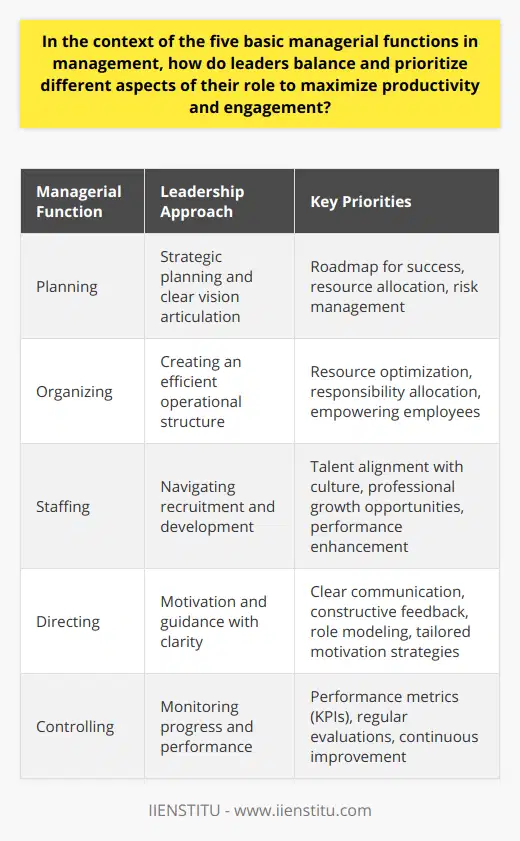
Drawing upon the seven main functions of management, what strategies can be employed to drive innovation and adaptability, while still maintaining a strong and stable organizational structure?
Innovation and Adaptability through Management Functions
To drive innovation and adaptability in an organization while maintaining a stable structure, it is crucial to apply effective strategies based on the seven main functions of management. These functions are planning, organizing, staffing, directing, coordinating, controlling, and reporting.
Strategic Planning and Organization
Firstly, incorporating innovation and adaptability into strategic planning helps define benchmarks and goals to measure progress and change. Managers should develop comprehensive and flexible plans, considering possible disruptions and shifting trends in the market. Proper organization entails wisely allocating resources and ensuring effective communication channels for seamless integration of innovative initiatives.
Talent Acquisition and Development
Staffing plays a critical role in fostering an innovative environment. Hiring individuals with diverse backgrounds and skillsets facilitates better problem-solving and encourages new perspectives. Providing continuous learning and development opportunities for employees also ensures they are equipped with relevant skills to adapt to change and contribute to innovation.
Leadership and Direction
Strong leadership and direction are essential in cultivating a culture of innovation and adaptability. Managers should lead by example, embracing change, and encourage employees to actively participate in decision-making processes. They should also establish a shared organizational vision, consistently engaging and motivating team members to pursue innovative practices.
Coordination and Control
Effective coordination across departments is vital for integrating innovative practices while maintaining stability. Managers should develop efficient communication channels and promote cross-functional collaboration to streamline processes and accelerate the adoption of new ideas. Simultaneously, controlling mechanisms provide a clear framework for evaluating the impact of innovations and ensuring adherence to organizational goals and objectives.
Performance Reporting
Transparent reporting protocols enable managers to track the progress of innovation initiatives against predetermined objectives. Regular performance reports help in identifying areas requiring improvement, fostering an environment of continuous learning, and adaptability. By utilizing these techniques, organizations can embrace and adapt to change while maintaining a strong and stable structure.
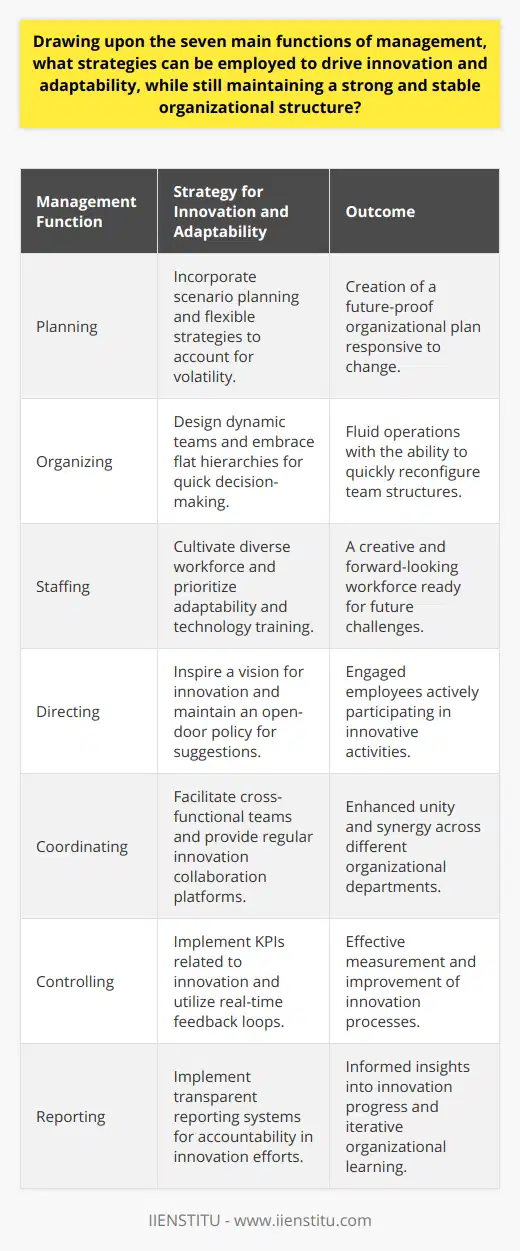
What are the key differences between the 5 basic managerial functions and the 4 basic functions of management, and how do these variations impact overall organizational performance?
Key Differences in Managerial Functions
The five fundamental managerial functions comprise planning, organizing, staffing, directing, and controlling, while the four basic functions of management are planning, organizing, directing, and controlling. The primary difference between these two sets of functions is the absence of staffing in the latter. This variation in management approaches has considerable implications for organizational performance, as illustrated below.
Role of Staffing in Organizational Performance
Staffing is critical in determining an organization's success, as it involves acquiring, developing, and retaining a talented and skilled workforce. Effective staffing ensures that employees are well-matched to their roles, adequately trained, and empowered to contribute to achieving organizational objectives. Thus, the five-function model places greater emphasis on human resource management compared to the four-function model, potentially leading to improved overall performance.
Impact of Staffing on Other Functions
The presence or absence of staffing in the management framework influences the execution of the other management functions. In the five-function model, staffing can enhance planning, organizing, directing, and controlling by ensuring that the organization has the right human resources to effectively implement strategic plans and operate within the organizational structure. Conversely, the four-function model might not explicitly focus on human resources, potentially creating gaps in the workforce and resulting in diminished efficiency.
Emphasis on Individual versus Collective Performance
The five-function model highlights the importance of individual employee competencies and their contributions to an organization's success. By focusing on staffing, this model acknowledges the impact of personal skills and capabilities on the organization's overall competitiveness. In contrast, the four-function model concentrates on collective performance, with less attention to the granular aspects of workforce management.
Continuous Improvement and Adaptability
Incorporating staffing into managerial functions fosters a culture of continuous improvement and adaptability within the organization. The five-function model encourages managers to invest in employee development and to develop strategies for anticipating and adapting to changes in the business environment. This flexibility translates into a more resilient organization able to respond to fluctuations in performance, whereas the four-function approach may not offer the same adaptability.
In conclusion, the key difference between the five basic managerial functions and the four basic functions of management lies in the former's inclusion of staffing as a crucial function. This variation impacts overall organizational performance in numerous ways, such as promoting effective workforce management, enhancing other management functions, and emphasizing individual contributions. Ultimately, the five-function model fosters an organizational culture of continuous improvement and adaptability, potentially resulting in improved performance over the long term.
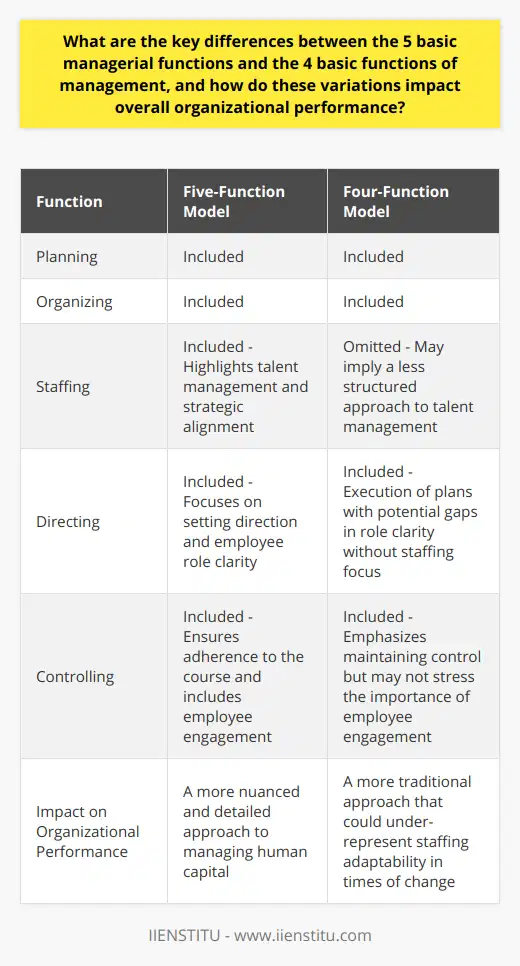
In the context of the 7 main functions of management, which roles are most closely associated with fostering employee motivation, and what strategies can be employed to strengthen this aspect of management?
Roles and Strategies for Employee Motivation
Role of the Manager
In the context of the seven main functions of management (planning, organizing, staffing, directing, coordinating, reporting, and budgeting), the roles most closely associated with fostering employee motivation are directing and coordinating. These roles involve the manager actively setting clear expectations, providing guidance and support, and ensuring harmonious collaboration among team members.
Setting Clear Expectations
To bolster employee motivation, the manager must define tasks, goals, and performance indicators in a precise manner. Clarity in communication minimizes confusion and enables employees to fully grasp their responsibilities. This understanding allows them to direct their efforts constructively, experience growth, and derive satisfaction from their work.
Providing Guidance and Support
Managers must offer ongoing guidance and support to their staff, both in terms of technical assistance and emotional encouragement. They must be available to answer questions, facilitate problem-solving, and provide timely feedback on performance. Such managerial engagement helps employees feel valued and supported, thereby enhancing their motivation to excel in their tasks.
Promoting a Collaborative Environment
A vital aspect of coordinating is fostering a collaborative atmosphere within the team. Encouraging open communication, idea-sharing, and teamwork enables employees to feel more connected to their colleagues and more committed to the organization. Additionally, working as a cohesive unit allows the team to accomplish goals more efficiently, contributing to a sense of collective achievement and motivation.
Recognition and Rewards
Another strategy to strengthen employee motivation is the implementation of a robust recognition and reward system. Recognizing and appreciating employees' achievements, both publicly and privately, helps them feel acknowledged and valued. Coupling recognition with appropriate rewards – such as promotions, incentives, or other forms of compensation – further motivates employees to maintain high performance.
In conclusion, to foster employee motivation, it is crucial for managers to focus on their roles in directing and coordinating, which encompass setting clear expectations, providing guidance and support, and promoting collaboration among their team members. Implementing effective recognition and reward systems can also contribute to a highly motivated workforce.
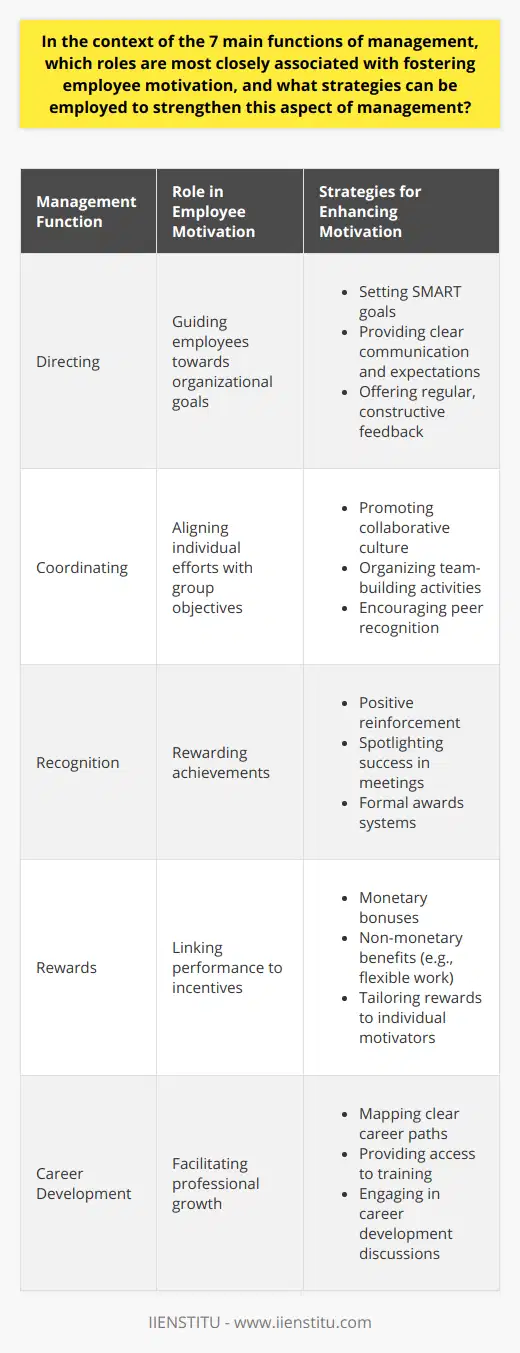
How do contemporary challenges, such as technological advancements and globalization, impact the execution and relevance of the 4 functions of management in modern organizations?
Impact of Technological Advancements
Technological advancements have greatly impacted the execution and relevance of the four functions of management: planning, organizing, leading, and controlling. With the advent of sophisticated technology, managers have access to vast amounts of data, which enables more precise planning and forecasting, thereby enhancing their ability to make informed decisions. Technology has also improved communication and coordination in organizations, facilitating smoother organization and increased efficiency in operations.
Globalization Effects on Management
Globalization, on the other hand, adds another layer of complexity to the management process. Expanding markets and increased interdependence necessitate a greater awareness of cultural, political, and economic factors. This has led to a shift in management practice, with a focus on adaptability, cross-cultural understanding, and knowledge of diverse markets. Consequently, contemporary leaders must now develop their abilities to navigate these more complex environments, while efficiently managing resources and talent.
Adapting Planning Function
Due to these challenges, the planning function of management has evolved. In modern organizations, strategic planning must be more flexible in order to account for the continuous changes in technology and global markets. Accordingly, managers need to regularly review their plans, assess outcomes, and make adjustments as necessary to ensure that the organization remains on track.
Organizing in Digital Era
Organizing, too, has changed with technological advancements and globalization. New organizational structures, such as virtual and matrix models, have emerged to accommodate remote work and international collaboration. Managers must now consider additional factors such as time zones, cultural norms, and communication channels when organizing team meetings and allocating tasks.
Leading with Emotional Intelligence
In this contemporary landscape, leading requires a more inclusive, empathetic, and empowering approach. Managers must develop emotional intelligence and cross-cultural competencies to effectively lead diverse teams. This involves understanding the unique needs, motivations, and experiences of team members, and implementing strategies to cultivate a positive and cohesive work environment.
Control in the Information Age
Finally, the controlling function of management has been altered by the proliferation of digital tools and methodologies. The use of data analytics, performance metrics, and software brings newfound capabilities to monitor and evaluate employee performance, financial outcomes, and overall organizational efficiency. However, managers must strike a balance between control and autonomy to maintain employee satisfaction and trust.
In conclusion, contemporary challenges, such as technological advancements and globalization, are influencing the execution and relevance of the four functions of management in modern organizations. As organizations continue to evolve, managers must adapt their practices to ensure their management functions remain current and effective in an ever-changing environment.
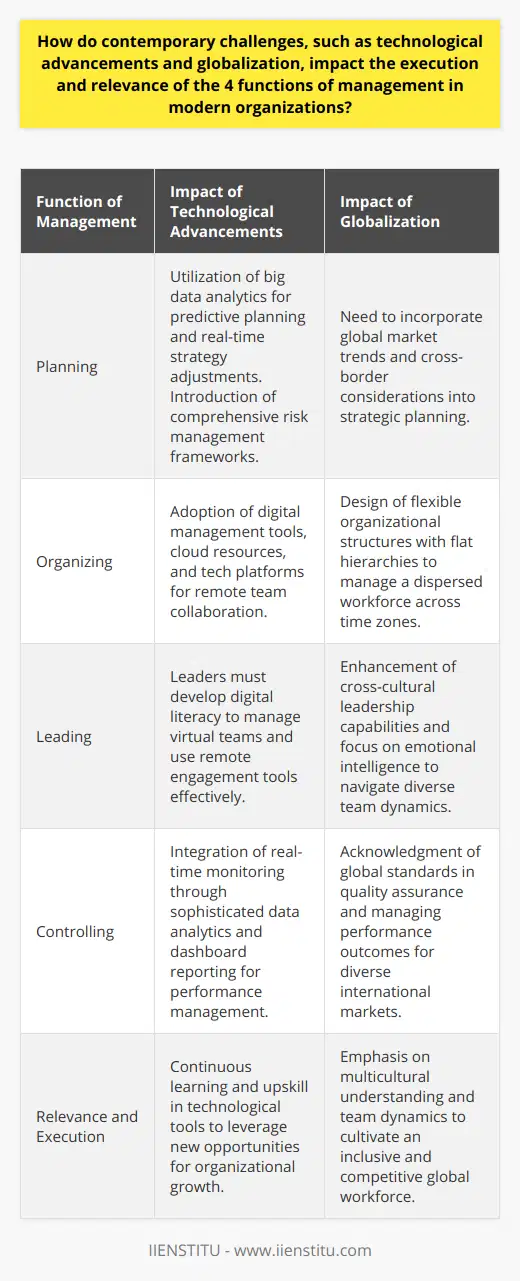
What are the most fundamental and basic functions of management in ensuring an organization's long-term sustainability and growth?
Planning and Strategy Formulation
A cardinal function of management involves planning and strategizing. It carves out the future trajectories for an organization by making efficient tactical decisions. Managers strategically design business plans and goals that lead an organization towards long-term sustainability and growth.
Organizing Resources
Management also entails the meticulous organization of resources. This covers allocation of manpower, finances, and other assets, helping the organization to methodically meet its objectives and goals. Organizing resources is pivotal for operational excellence and resilience.
Directing and Leadership
Directing forms an integral part of management. Managers must guide their teams to achieve their major strategic goals. Effective leadership instills motivation, resolves conflicts, and, ultimately, stimulates an organization's novel creative endeavors. These efforts are essential in preserving the organization's efficacy and growth.
Control and Monitoring
Another quintessential management function is control and monitoring. Managers must constantly evaluate their strategies and progress. They maintain organizational stability by periodically detecting deviations, correcting errors, and readjusting plans. This continuous process is crucial in safeguarding the organization's long-term consistency and expansion.
Human Resource Management
Lastly, the growth and sustainability of an organization revolve around its ability to manage its human resources effectively. Managers play a key role in recruitment, training, development, and retention of employees. An organization's competitive advantage lies in its capacity to acquire and retain talent, and management ensures this.
In summary, management plays a critical role in ensuring the long-term sustainability and growth of an organization. It achieves this through strategic planning, organizing resources, directing and leadership, control and monitoring, and effective human resource management. These multifaceted and interlinked functions work concurrently, shaping an organization's successful future.
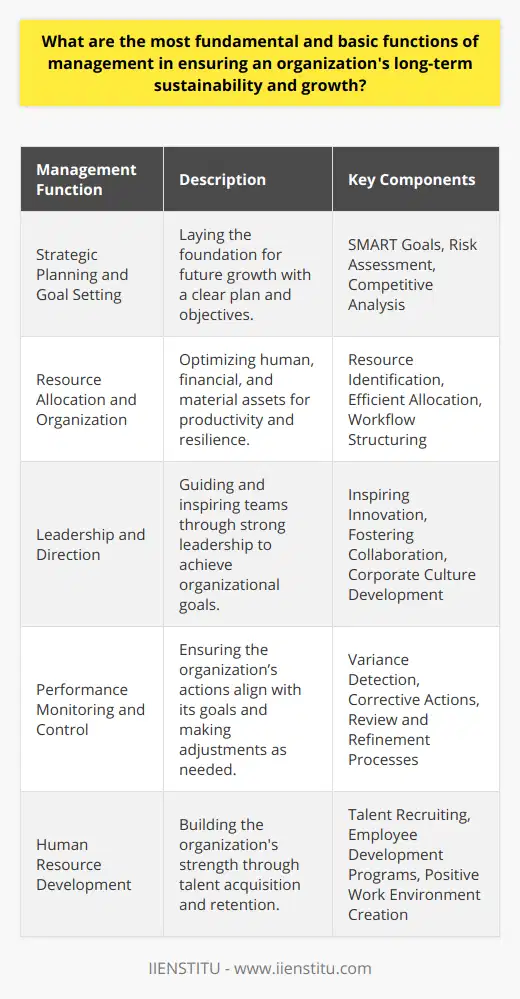
How do the 12 management functions interact with one another to create a comprehensive framework for efficient and effective organizational governance?
Interplay of Management Functions
In creating an efficient and adaptable organizational governance framework, the 12 management functions have crucial roles to play.
Visible Planning
The function of planning sets the direction for an organization. It maps out the course and articulates the strategies and tactics to achieve organizational objectives. Communicating this plan ensures the entire workforce remains informed and involved.
Organizing Resources
Organizing efficiently allocates human and non-human resources. This function focuses on assigning roles, aligning activities, and streamlining workflows. Consequently, it bolsters operational efficiency and spurs collaboration and coordination.
Effective Staffing
Staffing involves not just hiring but also developing and retaining personnel. It’s about placing the right people in the right positions. Moreover, it is instrumental in fostering a conducive environment that motivates and inspires.
Directing to Success
Effective directing entails supervising, motivating, and leading the workforce towards organizational goals. Good leadership inspires a collaborative spirit and catalyses the achievement of targets.
Controlling for Efficiency
The controlling function evaluates performance and rectifies deviations, maintaining an ordered and efficient organizational environment. This function begets organizational stability and operational efficiency.
Coordination and Collaboration
The function of coordination harmonizes the various functions of management. It ensures various departments and teams work in sync towards common goals.
Communication for Clarity
Effective communication aids in ensuring transparency, fostering trust, and facilitating the smooth execution of plans. It ensures everyone in the organization is on the same page.
Decision-Making
The decision-making function is about making sound and timely decisions to propel an organization on its strategic trajectory. It integrates information from various functions to formulate action steps.
Innovation for Expansion
The function of innovation centers on generating new ideas, products, and processes, endowed with the potential of enhancing productivity and competitiveness.
Representation and Liaison
The representation function puts the organization in the public sphere, liaising with external entities. It also champions the image of the organization.
Crisis Management
Crisis management or disaster management ensures an organization can navigate and survive unforeseen setbacks or crises.
Monitoring the Environment
This function entails tracking relevant external factors that may impact the organization and responding accordingly. It’s about staying attuned to changes in the business environment.
In summary, the 12 functions interact synergistically, operating not in isolation but complementing each other. This systemic and integrative approach forms a comprehensive framework for efficient and effective organizational governance.

In the context of the four basic management functions, what role does innovation play in driving continuous improvement and adaptability in the face of evolving industry landscapes and challenges?
Role of Innovation in Management Functions
Innovation holds an essential position in the four fundamental domains of management: planning, organizing, leading, and controlling. Its role transcends routine operations, often driving continuous enhancement and flexibility in fast-changing industry environments.
Innovative Planning
Planning, the first management function, delineates the roadmap for organizations. Innovation propels revolutionary planning methods, paving the way for long-term accomplishments and growth. It advances the strategizing capability of an organization, enabling its shift from static planning to dynamic, future-oriented strategies.
Organizing through Innovation
Organizing involves creating a structured system suitable for meeting the overall goals. By embedding innovation, organizations can circumnavigate the conventional and mundane, encouraging creative processes. Through innovative structures, organizations can leverage their resources effectively, thereby increasing efficiency.
Leadership and innovation
Leadership extends beyond instruction and supervision. It involves inspiring and motivating employees. Integrating innovation into leadership practices can foster a fertile culture of creativity, encouraging employees to develop inventive solutions to challenges. Consequently, this promotes resilience and adaptability in the workforce.
Innovation in Control
Lastly, controlling, which entails monitoring and adjusting company processes, can significantly benefit from innovation. Innovative controlling approaches can bring about superior performance measures, enhancing problem-solving and decision-making processes. The end result is an organization better equipped to respond to changes.
Conclusion
Thus, innovation sustains continuous improvement and adaptability across the four basic management functions. It promotes a proactive approach, enabling organizations to seize opportunities and mitigate threats in evolving industry landscapes. Innovation, therefore, acts as a driving catalyst in today's hyper-competitive, volatile business environments.
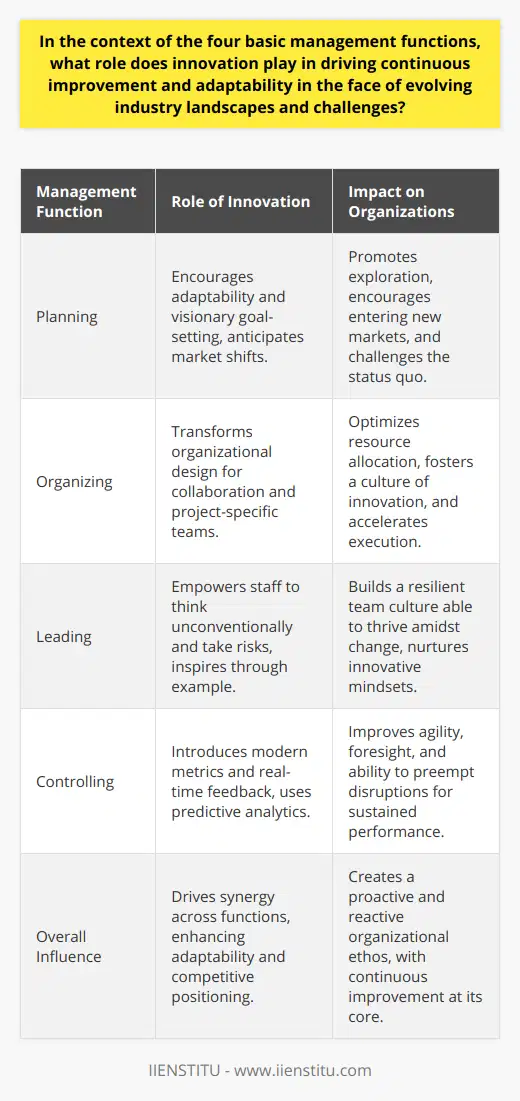
What is the most basic and fundamental of all management functions, and how does it lay the foundation for organizational success?
Fundamental Management Function
The planning function stands as the most basic and fundamental of all management functions. It governs all subsequent functions: organizing, leading, and controlling. Therefore, effective planning becomes crucial in laying a strong foundation for organizational success.
Role of Planning
Planning entails defining goals,- establishing strategies to achieve these goals, and developing plans to integrate and coordinate activities. These actions allow organizations to allocate resources efficiently, have a clear direction and anticipate potential issues.
Planning and Organizational Success
Strategic planning directly influences organizational success as it aligns all organizational actions towards the same goal. It consolidates the organization's vision, mission, and objectives. Consequently, strategic planning provides a framework for all other management functions.
Efficiency in Resource Allocation
Through the planning process, managers can optimize the allocation of resources - employee time, skills, and finances. This efficiency reduces waste, increases productivity, and contributes significantly to an organization's overall success.
Proactive versus Reactive
Planning enables managers to be proactive instead of reactive. Proactive planning allows identification of potential threats and opportunities in time to allow for the development of proper contingency plans. This prevents hasty, less effective, reactive decision-making in the face of unexpected obstacles.
Direction and Cohesion
By communicating a clear direction, planning fosters cohesion and encourages employee alignment with the organization's objectives. This unity is a key ingredient of a successful organization where everyone strives towards shared goals.
To sum up, thoughtful and strategic planning plays a pivotal role in the success of an organization. It provides a guiding framework, encourages efficiency, enables proactive management, and fosters unity and cooperation among staff. Thus, planning serves as the most basic and fundamental management function and the foundation for organizational success.
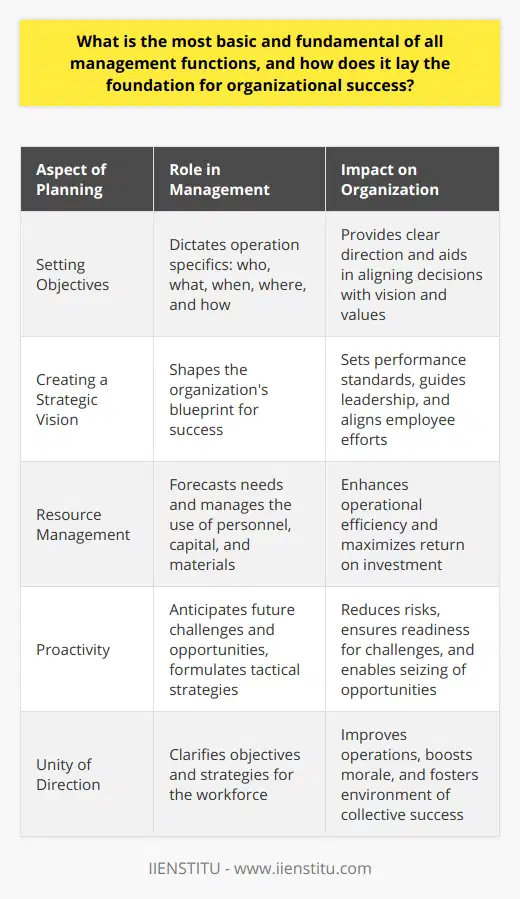
How do the 12 management functions contribute to the overall efficiency and growth of an organization, and what strategies can be employed to maximize their effectiveness?
**Role of Management Functions**
The 12 management functions serve as the backbone in bolstering the overall efficiency and growth of an organization. Establishing strategic planning sets the foundation for achieving targeted organizational goals. When an entity excels in organizing and staffing, it facilitates smooth operations and optimal use of resources. In doing so, it paves the way for effective team collaboration and promotes efficient processes and procedures.
**Directing and Controlling**
Directing ensures people work together toward common goals, while controlling spotlights the need for regular evaluation and rectification of activities to warrant that the organization remains on track. Moreover, management functions also involve rewarding exemplary performance which bolsters staff morale and productivity, thus contributing to organizational growth.
**Leveraging Decision-Making and Communication**
Insightful decision-making, which is vital, aids in navigating the organization through market uncertainties. Additionally, sound communication strategies establish clear lines of information flow, promoting transparency and mutual trust.
**Strategies for Effectiveness**
Rope in the world of data analytics with the aim to enhance the effectiveness of these functions. Employ advanced data-driven strategies in decision-making, staffing, and forecasting. These ensure the organizational strategies align with real-time market dynamics.
**Importance of Training and Mentorship**
Prioritize continuous training and mentorship programs to upskill the staff. These will amplify their role in fulfilling the organizational objectives and will ensure that they can handle new technology efficiently and effectively.
**Embracing Technology and Innovation**
Tie the thriving technology in improving communication using digital tools. Leverage innovative practices to keep the organizational functions updated and invigorated. This paves the way toward a dynamic, continually evolving workplace, in tune with forward-leaning trends and developments.
To conclude, optimizing the 12 management functions to benefit an organization necessitates a multipronged approach that leverages data-driven decision making, continuous training, and the adoption of advanced technology. With a commitment to these strategies, organizations are poised to maximize growth and efficiency.
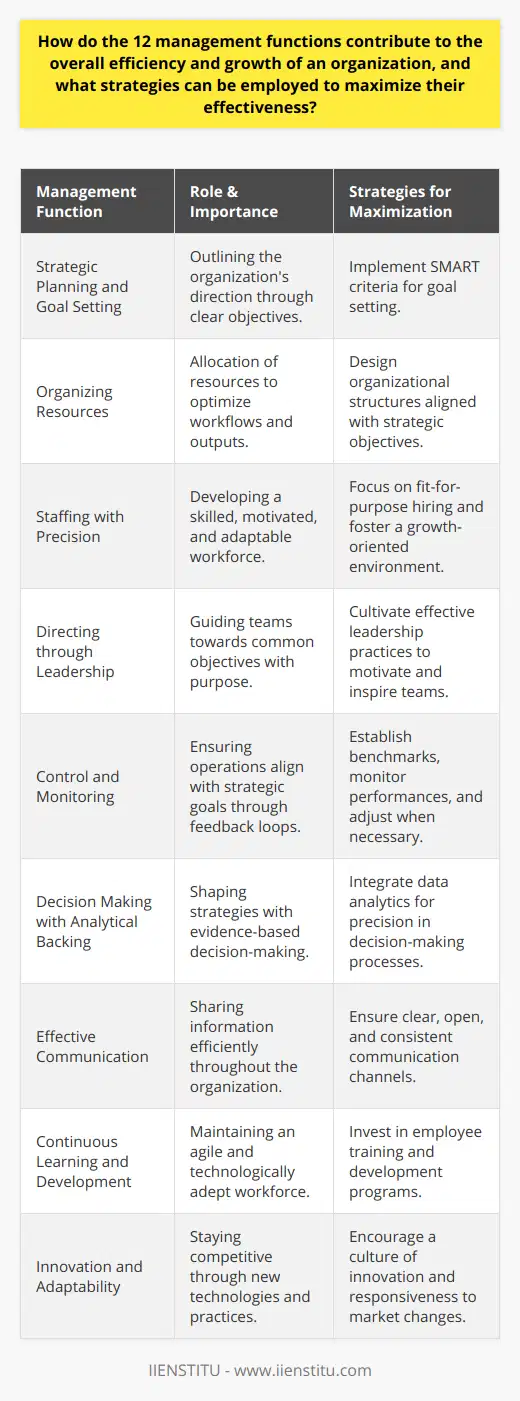
In the context of the four basic management functions, how do these roles adapt to evolving business environments and changing industry trends to ensure long-term organizational sustainability?
Planning in a Changing Environment
One of the four basic functions of management adapts to evolving business environments through strategic planning. Managers constantly scan the external environment to understand market trends and forecast future conditions, and align organizational objectives accordingly. Redefining goals according to changing industry trends is vital for long-term sustainability.
Organizing in a Dynamic Business Scenario
In the context of organizing, managers must be flexible to meet the demands of a fluctuating marketplace. They must routinely modify the organizational structure, work tasks and reporting relationships to not only accommodate but also exploit changes. This increases agility and promotes sustainability.
Directing Amidst Business Evolution
Directing, another management function, requires managers to motivate and lead employees to adapt to evolving environments. With astute leadership skills, managers can communicate the effects of changing industry trends and guide their teams towards formulating proactive strategies and responses. This approach aids in building a resilient and adaptable workforce, able to meet ongoing challenges.
Controlling for Sustainable Business
Last, the controlling function enables managers to monitor performance and correct deviations from set standards. In the context of business evolution, this includes tweaking systems and processes based on feedback and analytics. Implementation of stringent yet flexible control measures allows managers to ensure alignment with evolving market demands, ensuring long-term sustainability.
In essence, adaptation to changing business environments and industry trends within the four management functions can enhance organizational resilience and ensure the sustainable growth of businesses. By regularly scanning and interpreting external changes, managers can align organizational strategies for success in a dynamic marketplace.
